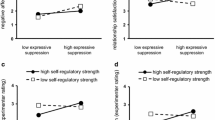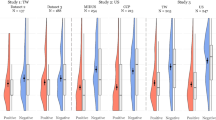Abstract
Research has taken a dim view of regulating emotions via expressive suppression. However, the impact of suppression may vary according to individuals’ interpersonal orientation. In two studies, we examined the effects of suppression under self-transcendent and self-interest orientations. Results revealed that (1) in everyday life, although dispositional suppression was related to lower psychological well-being, the costs associated with suppression were buffered among individuals with a self-transcendence orientation (Study 1); and (2) among individuals primed with a self-transcendence orientation, suppression of negative emotions in an interpersonal conflict situation led to lower levels of anger-related emotions and higher levels of perceived relational quality compared to emotional expression; however, among individuals primed with a self-interest orientation, suppression led to higher levels of anger-related emotions and lower levels of perceived relational quality compared to expression (Study 2). Together, results from the present study highlight the role of interpersonal orientation in moderating the effects of suppression on well-being.



Similar content being viewed by others
Notes
Self-transcendence can be either a trait or a state, as it can be measured as an individual difference or be induced in laboratory settings (Bauer and Wayment 2008). In Piff et al.’s (2015) study, for instance, participants were induced to experience feelings of awe, which in turn led to decreased self-concerns and increased compassionate behaviors. Moreover, studies using daily and weekly reports of compassionate and self-image goals (e.g., Crocker and Canevello 2008) have shown that not only do people differ in their average level of self-transcendence across time, there are day-to-day, week-to-week, and even moment-to-moment fluctuations as well.
The Chinese version of the Compassionate and Self-image Goals Scale (CSGS) was translated and revised by Chang, Lin, Huang, and Lin (in press). The Chinese CSGS compassionate and self-image subscale scores had good internal reliability (Cronbach’s alpha of .88 and .82 for compassionate goals and self-image goals, respectively). The Chinese version of the ERQ was downloaded from the Stanford Psychophysiological Laboratory website (http://spl.stanford.edu/). The Chinese version of the Scale of Psychological Well-Being was also translated and revised in a previous study (Cronbach’s alpha = .94; Liao and Cheng 2011).
We did not control for age or gender in the main analyses, because the results remained the same whether or not these variables were included as covariates.
References
Aiken, L. S., & West, S. G. (1991). Multiple regression: Testing and interpreting interactions. Newbury Park, CA: Sage.
Bauer, J. J., & Wayment, H. A. (2008). The psychology of the quiet ego. In H. Wayment & J. Brauer (Eds.), Transcending self-interest: Psychological explorations of the quiet ego (pp. 7–19). Washington, DC: American Psychological Association.
Baumeister, R. F., & Leary, M. R. (1995). The need to belong: Desire for interpersonal attachments as a fundamental human motivation. Psychological Bulletin, 117, 497–529. doi:10.1037/0033-2909.117.3.497.
Bowlby, J. (1969). Attachment and loss (vol. 1) attachment. New York, NY: Basic Books.
Burson, A., Crocker, J., & Mischkowski, D. (2012). Two types of value-affirmation: Implications for self-control following social exclusion. Social Psychological and Personality Science, 3, 510–516. doi:10.1177/1948550611427773.
Butler, E. A., Egloff, B., Wilhelm, F. H., Smith, N. C., Erickson, E. A., & Gross, J. J. (2003). The social consequences of expressive suppression. Emotion, 3, 48–67. doi:10.1177/1754073908099131.
Butler, E. A., Lee, T. L., & Gross, J. J. (2007). Emotion regulation and culture: Are the social consequences of emotion suppression culture-specific? Emotion, 7, 30–48. doi:10.1037/1528-3542.7.1.30.
Canevello, A., Granillo, M. T., & Crocker, J. (2013). Predicting change in relationship insecurity: The roles of compassionate and self-image goals. Personal Relationships, 20, 587–618. doi:10.1111/pere.12002.
Chang, J. H., Lin, S. H., Huang, C. L., & Lin, Y. C. (in press). The Chinese version of compassionate and self-image goal scale and its’ relationship with self-regulation. Chinese Journal of Guidance and Counseling.
Cohen, G. L., & Sherman, D. K. (2014). The psychology of change: Self-affirmation and social psychological intervention. Annual Review of Psychology, 65, 333–371. doi:10.1146/annurev-psych-010213-115137.
Consedine, N. S., Magai, C., & Bonanno, G. A. (2002). Moderators of the emotion inhibition-health relationship: A review and research agenda. Review of General Psychology, 6, 204–228. doi:10.1037//1089-2680.6.2.204.
Crocker, J. (2008). From egosystem to ecosystem: Implications for learning, relationships, and well-being. In H. Wayment & J. Brauer (Eds.), Transcending self-interest: Psychological explorations of the quiet ego (pp. 63–72). Washington, DC : American Psychological Association. doi: 10.1037/11771-006.
Crocker, J., & Canevello, A. (2008). Creating and undermining social support in communal relationships: The role of compassionate and self-image goals. Journal of Personality and Social Psychology, 95, 555–575. doi:10.1037/0022-3514.95.3.555.
Crocker, J., & Canevello, A. (2012). Consequences of self-image and compassionate goals. Advances in Experimental Social Psychology, 45, 229–277. doi:10.1016/b978-0-12-394286-9.00005-6.
Crocker, J., Niiya, Y., & Mischkowski, D. (2008). Why does writing about important values reduce defensiveness? Self-affirmation and the role of positive other-directed feelings. Psychological Science, 19, 740–747. doi:10.1111/j.1467-9280.2008.02150.x.
Dambrun, M., & Ricard, M. (2011). Self-centeredness and selflessness: A theory of self-based psychological functioning and its consequences for happiness. Review of General Psychology, 15, 138–157. doi:10.1037/a0023059.
Deci, E. L., & Ryan, R. M. (2000). The “what” and “why” of goal pursuits: Human needs and the self-determination of behavior. Psychological Inquiry, 11, 227–268. doi:10.1207/s15327965pli1104_01.
Friedman, H. S., & Miller-Herringer, T. (1991). Nonverbal display of emotion in public and in private: Self-monitoring, personality, and expressive cues. Journal of Personality and Social Psychology, 61, 766–775. doi:10.1037//0022-3514.61.5.766.
Gross, J. J. (1998). Antecedent- and response-focused emotion regulation: Divergent consequences for experience, expression, and physiology. Journal of Personality and Social Psychology, 74, 224–237. doi:10.1037/0022-3514.74.1.224.
Gross, J. J. (1999). Emotion regulation: Past, present, future. Cognition and Emotion, 13, 551–573. doi:10.1080/026999399379186.
Gross, J. J., & John, O. P. (1998). Mapping the domain of emotional expressivity: Multi-method evidence for a hierarchical model. Journal of Personality and Social Psychology, 74, 170–191.
Gross, J. J., & John, O. P. (2003). Individual differences in two emotion regulation processes: Implications for affect, relationships, and well-being. Journal of Personality and Social Psychology, 85, 348–362. doi:10.1037/0022-3514.85.2.348.
Gross, J. J., & Levenson, R. W. (1993). Emotional suppression: Physiology, self-report, and expressive behavior. Journal of Personality and Social Psychology, 64, 970–986. doi:10.1037/0022-3514.64.6.970.
Heine, S. J., Lehman, D. R., Markus, H. R., & Kitayama, S. (1999). Is there a universal need for positive self-regard? Psychological Review, 106, 766–794. doi:10.1037/0033-295X.106.4.766.
Hofstede, G. (1984). Culture’s consequences: International differences in work-related values. Beverly Hills, CA: Sage.
Hofstede, G. (2001). Culture’s consequences: Comparing values, behaviors, institutions and organizations across nations. Thousand Oaks, CA: Sage.
Hofstede, G., Hofstede, G. J., & Minkov, M. (2010). Cultures and organizations: Software of the mind. New York: McGraw-Hill.
Huang, C.-L., Chung, C. K., Hui, N., Lin, Y.-C., Seih, Y.-T., Chen, W.-C., et al. (2012). The development of the Chinese Linguistic Inquiry and Word Count Dictionary. Chinese Journal of Psychology, 54, 185–201.
Keltner, D., Kogan, A., Piff, P. K., & Saturn, S. R. (2014). The sociocultural appraisals, values, and emotions (SAVE) framework of prosociality: Core processes from gene to meme. Annual Review of Psychology, 65, 425–460. doi:10.1146/annurev-psych-010213-115054.
Kennedy-Moore, E., & Watson, J. C. (1999). Expressing emotion: Myths, realities, and therapeutic strategies. New York, NY: Guilford Press.
Leary, M. R., & Terry, M. L. (2012). Hypo-egoic mindsets: Antecedents and implications of quieting the self. In M. R. Leary & J. P. Tangney (Eds.), Handbook of self and identity (2nd ed.). New York: Guilford.
Liao, H. W., & Cheng, C. L. (2011). Identity status, self-defining memory, and psychological well-being in emerging adulthood. Research in Applied Psychology, 51, 79–110.
Matsumoto, D. (2006). Are cultural differences in emotion regulation mediated by personality traits? Journal of Cross-Cultural Psychology, 37, 421–437. doi:10.1177/0022022106288478.
Moeller, S. J., Crocker, J., & Bushman, B. J. (2009). Creating hostility and conflict: Effects of entitlement and self-image goals. Journal of Experimental Social Psychology, 45, 448–452. doi:10.1016/j.jesp.2008.11.005.
Otway, L. J., & Carnelley, K. B. (2013). Exploring the Associations between Adult Attachment Security and Self-actualization and Self-transcendence. Self and Identity, 12, 217–230. doi:10.1080/15298868.2012.667570.
Pennebaker, J. W., Chung, C. K., Ireland, M., Gonzales, A., & Booth, R. J. (2007). The Development and Psychometric Properties of LIWC2007: LIWC.net.
Piff, P. K., Dietze, P., Feinberg, M., Stancato, D. M., & Keltner, D. (2015). Awe, the small self, and prosocial behavior. Journal of Personality and Social Psychology, 108, 883–899. doi:10.1037/pspi0000018.
Polivy, J. (1998). The effects of behavioral inhibition: Integrating internal cues, cognition, behavior, and affect. Psychological Inquiry, 9, 181–204. doi:10.1207/s15327965pli0903_1.
Russell, J. A., Weiss, A., & Mendelsohn, G. A. (1989). Affect grid: A single-item scale of pleasure and arousal. Journal of Personality and Social Psychology, 57, 493–502. doi:10.1037//0022-3514.57.3.493.
Ryff, C. D., & Keyes, C. L. M. (1995). The structure of psychological well-being revisited. Journal of Personality and Social Psychology, 69, 719–727. doi:10.1037/0022-3514.69.4.719.
Soto, J. A., Perez, C. R., Kim, Y.-H., Lee, E. A., & Minnick, M. R. (2011). Is expressive suppression always associated with poorer psychological functioning? A cross-cultural comparison between European Americans and Hong Kong Chinese. Emotion, 11, 1450–1455.
Srivastava, S., Tamir, M., McGonigal, K. M., John, O. P., & Gross, J. J. (2009). The social costs of emotional suppression: A prospective study of the transition to college. Journal of Personality and Social Psychology, 96, 883–897. doi:10.1037/a0014755.
Su, J. C., Lee, R. M., & Oishi, S. (2013). The role of culture and self-construal in the link between expressive suppression and depressive symptoms. Journal of Cross-Cultural Psychology, 44, 316–331.
Tamir, M., Mitchell, C., & Gross, J. J. (2008). Hedonic and instrumental motives in anger regulation. Psychological Science, 19, 324–328. doi:10.1111/j.1467-9280.2008.02088.x.
Tausczik, Y. R., & Pennebaker, J. W. (2010). The psychological meaning of words: LIWC and computerized text analysis methods. Journal of Language and Social Psychology, 29, 24–54. doi:10.1177/0261927x09351676.
Tavris, C. (1984). On the wisdom of counting to ten: Personal and social dangers of anger expression. Review of Personality & Social Psychology, 5, 170–191.
Thompson, R. A. (1994). Emotion regulation: A theme in search of definition. Monographs of the Society for Research in Child Development, 59, 25–52. doi:10.1111/j.1540-5834.1994.tb01276.x.
Vitaliano, P. P., DeWolfe, D. J., Maiuro, R. D., Russo, J., & Katon, W. (1990). Appraised changeability of a stressor as a modifier of the relationship between coping and depression: A test of the hypothesis of fit. Journal of Personality and Social Psychology, 59, 582–592. doi:10.1037/0022-3514.59.3.582.
Wei, M., Su, J. C., Carrera, S., Lin, S.-P., & Yi, F. (2013). Suppression and interpersonal harmony: A cross-cultural comparison between Chinese and European Americans. Journal of Counseling Psychology, 60, 625–633.
Yeager, D. S., Henderson, M. D., Paunesku, D., Walton, G. M., D’Mello, S., Spitzer, B. J., & Duckworth, A. L. (2014). Boring but important: A self-transcendent purpose for learning fosters academic self-regulation. Journal of Personality and Social Psychology, 107, 559–580. doi:10.1037/a0037637.
Acknowledgments
We acknowledge the support of National Taiwan University and the Ministry of Science and Technology, Taiwan (Research Grant Number: NSC 101-2410-H-002-094-MY2).
Author information
Authors and Affiliations
Corresponding author
Rights and permissions
About this article
Cite this article
Kao, CH., Su, J.C., Crocker, J. et al. The Benefits of Transcending Self-Interest: Examining the Role of Self-Transcendence on Expressive Suppression and Well-Being. J Happiness Stud 18, 959–975 (2017). https://doi.org/10.1007/s10902-016-9759-4
Published:
Issue Date:
DOI: https://doi.org/10.1007/s10902-016-9759-4




